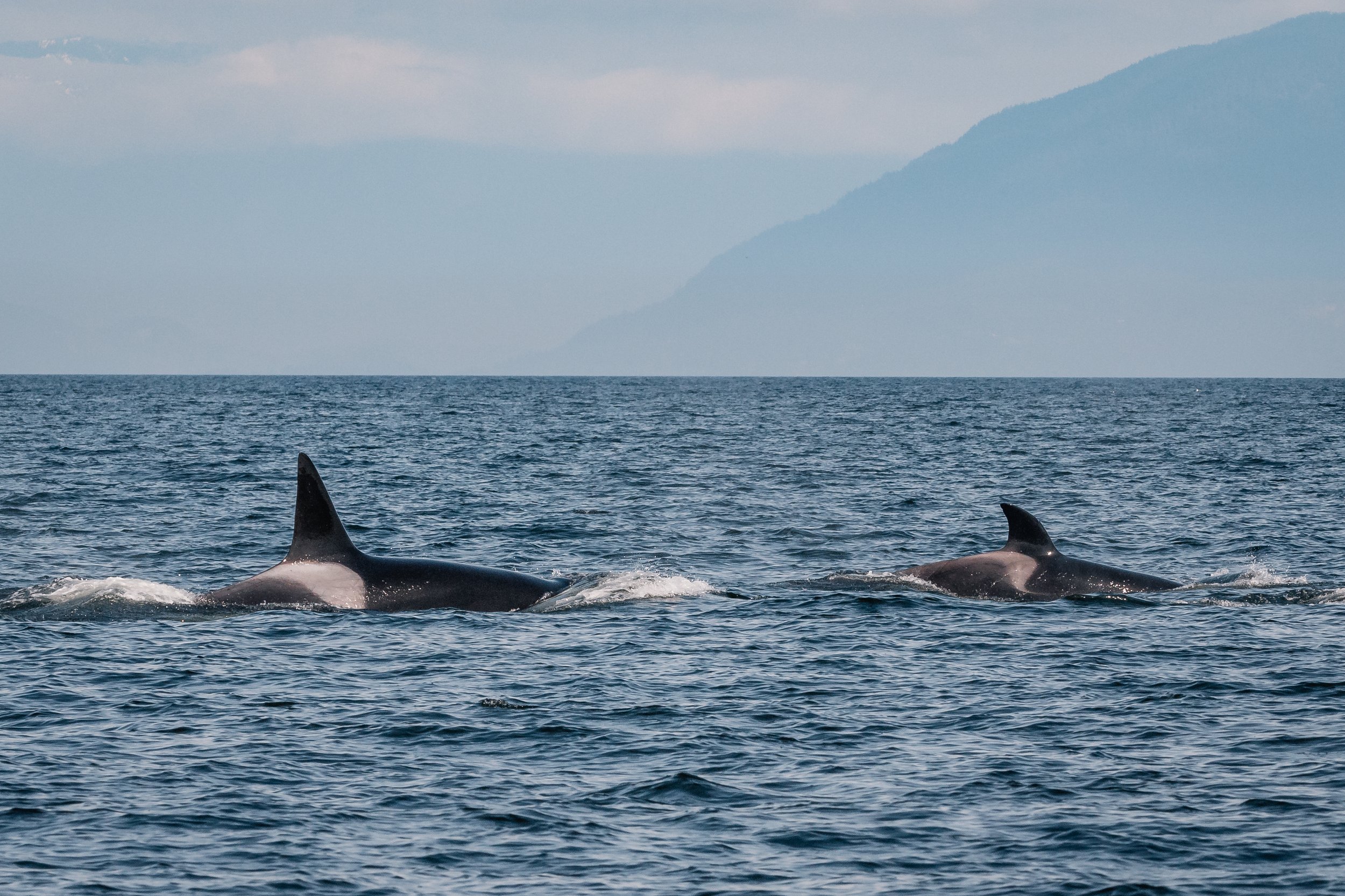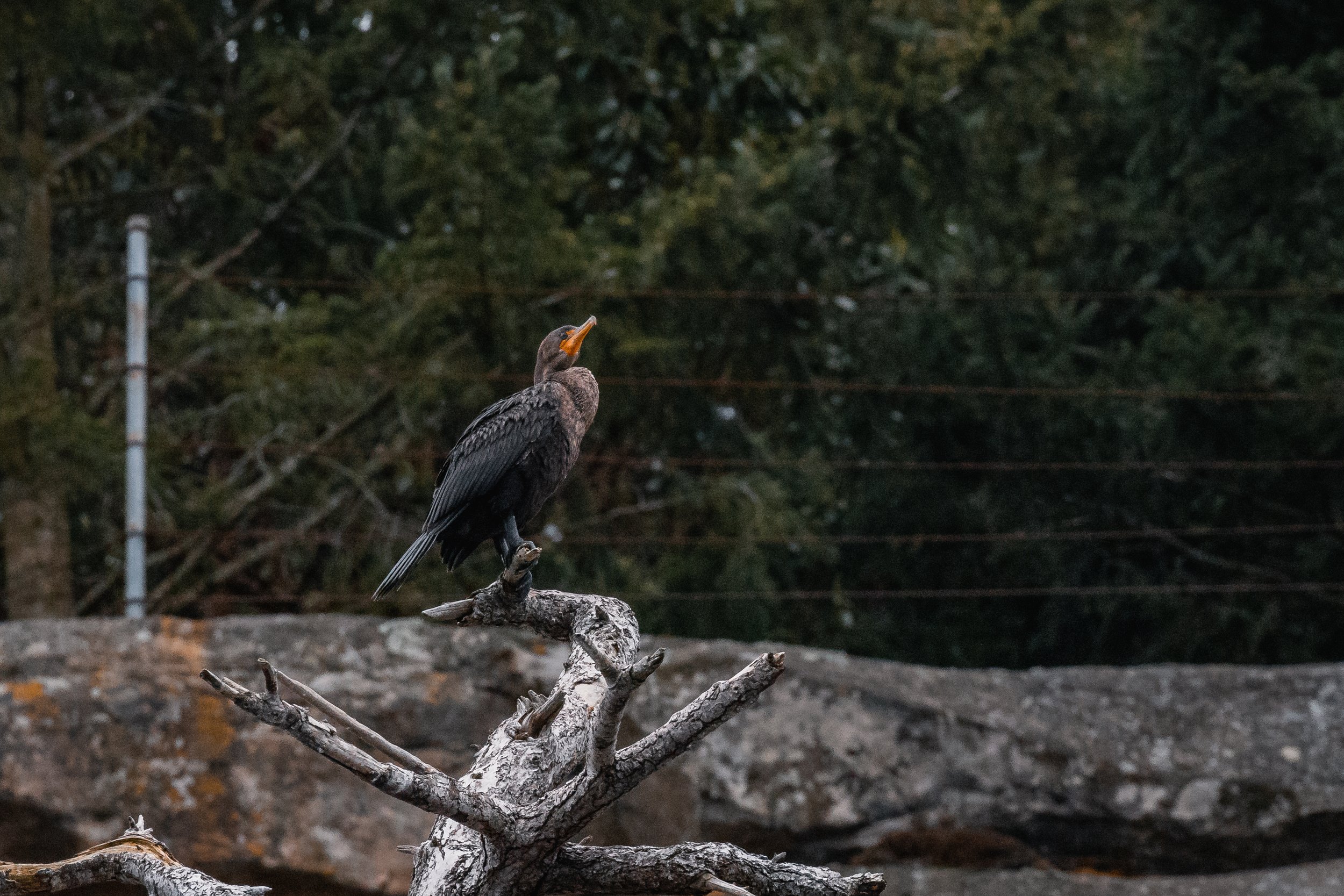March 29, 2022 - Orca party off Gabriola
The Salish Sea is a very large area, starting in the north near Quadra Island and extending down through the Georgia Strait, the Puget Sound, and the Juan de Fuca Strait. This huge area is where our whales spend a lot of their time, traveling ad looking for food or socializing with friends and family. We travel throughout the Strait of Georgia during our tours looking for whales and other wildlife. These days we primarily watch the Transient Orcas who normally travel in small groups of 2-6 individuals. Looking for the groups on the water can feel a lot like looking for a needle in a haystack. Thankfully there are 109 pods that travel through our region, this includes lone females and lone males as their own “pod”.
Lately we’ve been seeing a lot of T-parties, often with pods that have welcomed a new little whale to the family in the last few months. These T-parties are usually full of life and always a treat to see. Today we got to spend our time with another T-party - the T037’s, T037A’s, T049C, T036’s and the T137’s were all together traveling south along the East side of Gabriola Island.
T036 - Flapjack, ♀ Matriarch, <1970
T036B - Tattertip, ♀ 1998
T036B1 - Bhotia, 2009
T036B2 - Greenfelder, 2013
T036B3 - Chip, ♂ 2018
T037 - Rocky III, ♀ Matriarch, 1979
T037B - Harold, ♀ 1998
T037B1 - Lance, ♂ 2012
T037A - Volker, Matriarc, 1994
T037A1 - Inyo, ♂ 2007
T037A2 - Inky, ♂ 2009
T037A3 - Spinnaker, 2013
T037A4 - Crinkle, ♀ 2015
T037A5 - 2019 ♂
T137 - Loon, ♀ Matriarch ~1984
T137A - Jack, ♂ 2002
T137B - Tempest, 2006
T137D - Wright, 2012
T049C - Janet, Lone male, 1998
These 4 pods plus a lone male, Janet, were cruising along, traveling, and looking for afternoon snacks. Orcas need a lot of food to have the energy to be constantly traveling through our waters. On average an adult Orca will need about 300 lbs of food per day. Orca’s primarily feed on harbour seals that average about 200 lbs as adults, so each adult Orca needs about 1.5 adult harbour seals per day. That’s quite a lot of food. It’s for this reason we think that Transient Orcas usually travel in small groups, with the most common pod size being 4 whales, many pods range from 2-5 individuals. It’s easier for small groups to find the food they need because Seals and Sea Lions are smart, and once Orcas have been through and had a bite to eat, the other prey usually leave the area or haul up out of the water much too high for the Orcas to get.
This group of 18 whales would need approximately 5400 lbs of food, for just one day. That’s about 27 seals. No wonder they travel in smaller groups. Finding 6 seals is a lot easier than finding 27. Although, in larger groups like this Orcas can take on much larger and faster prey, like sea lions, which can weigh over 1000 lbs. That would certainly make a nice snack for this group of whales.
One of the cool things about this T-party is the family relations between the pods. As female Orcas begin having their own calves, they will start to spend more time away from mom, eventually leaving the pod all together with their own calves and becoming their own separate pod. T036 Flapjack is not only mom to T036B Tattertip, but she’s also believed to be the mother of T137 Loon.
Because we only started really studying Orcas in the 70’s we aren’t too sure on the family ties whales would have had before then. Loon and Flapjack were documented leading their own pods separately and it wasn’t until much later that we made the connection and realized that they were likely related. We can’t say 100% for sure because we don’t genetically test our Orcas, but it’s likely that Loon was here to hang out with her mom, sister, and their families.
Likewise, T037 Rocky III is T037A Volker’s mom. This means we had 2 little family reunions going on in the same party today. Mature females will revisit mom often to check in on their families, introduce new family members, or just to get together and hang out. Orcas are incredibly family oriented animals and form lifelong bonds with each other.
Below are some of the photos taken by Marine Naturalist Rebecca Stirling.
T037B Lance (right) surfacing alongside another member of the T-party, with more in the background.
T037B1 Lance surfacing. You can tell from the dark stripe along his saddle patch.
T137A Jack plowing through the water!
T037 Rocky III in the background with her grandson T037B1 Lance in the foreground.
More t-party action!
Rocky III surfacing.
T037B Harald surfacing.
Rocky III T037 (left) and Crinkle T037A4 (right) surfacing together.
Rocky III T037 (left) and Crinkle T037A4 (right) surfacing together.
Jack Attack!
Juvenile Bald Eagles.
Juvenile Bald Eagles fighting over scraps.
Steller Sea Lions hauled out near Valdes Island.
The fight between eagles continues with the sea lions watching.
Juvenile bald eagle in flight!
Harbour Seals hauled out on the rocks!
California Sea Lion on the log booms enjoying a nap.
The cormorants have returned to their nests!
The turkey vultures are also back!



























